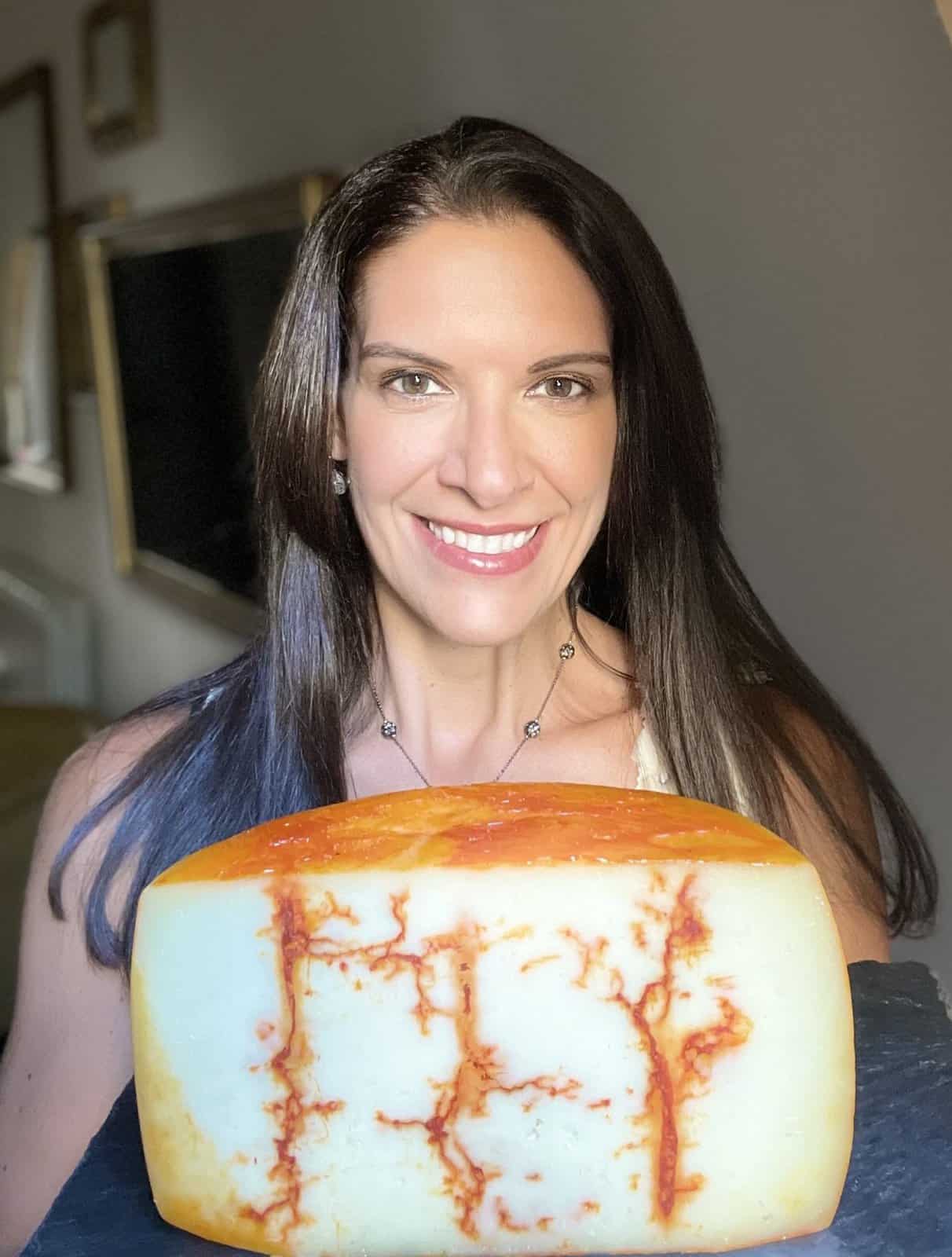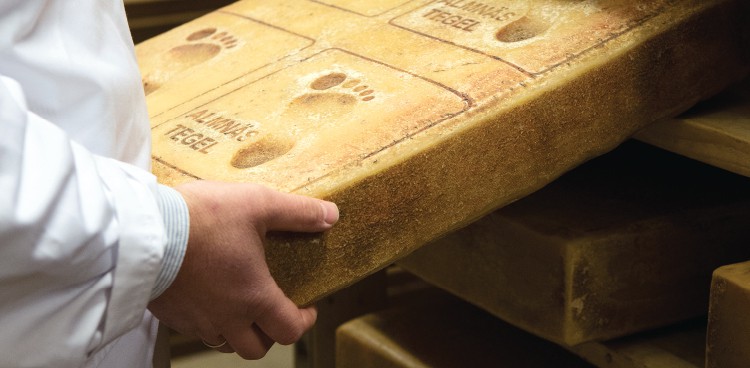
Almnäs Tegel is undoubtedly unlike any cheese you’ve ever seen before. Weighing a hefty 57 to 59 pounds, this squareshaped, hard cow’s milk cheese resembles a rustic tome with four imprints of a child’s foot on its speckled brown rind. “People see it and say, ‘Wow, is that a cheese? For real?’” says Kerstin Johansson, one of the cheesemakers.
Tegel (which translates to “brick” in Swedish) is produced at Almnäs Bruk, an organic farm on the picturesque west coast of Lake Vättern, the second largest lake in Sweden. While the cheese itself has only been in existence since 2008, the history behind it dates back to the 18th century. In the 1750s, the Almnäs Bruk estate was home to a brick factory. Workers would leave newly made bricks out to dry in the sun, and children who lived on the farm would run over them while playing, unwittingly leaving their footprints.
“In fact, some of those bricks were used in the construction of the manor house, which was built around 1766,” says the estate’s managing director, Thomas Berglund. “You can still see a number of bricks with children’s footprints on them in the floor of the attic today.”
Eventually, a child’s footprint became the logo imprinted on all bricks manufactured at Almnäs, and these bricks served as the foundation of the farm, both literally and figuratively. Berglund, who grew up on the estate with his three siblings, recalls building caves amid piles of bricks and making figurines from lumps of clay that served as the raw material.
“We would shape little people and trolls and deliver them to the factory. Months later they’d open up the furnace and we’d get them back. We’d have all forgotten about them by then,” Berglund says, laughing. Brick production ceased in 1976, but the concept persisted. In conceiving Tegel cheese, Berglund wanted to pay tribute to the bricks that had played an important role at Almnäs for hundreds of years.
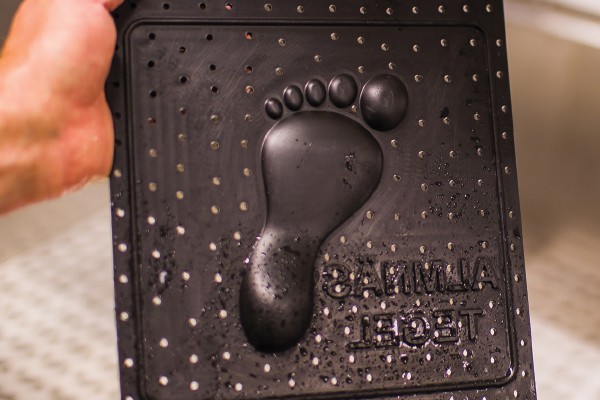
Reviving a Tradition
Berglund’s great grandfather bought the 6,400-acre Almnäs Bruk estate in 1916, but previous owners had been making cheese on the farm since 1830. One of those cheeses, Wrångebäck Sweden, became the first officially registered cheese brand in the country (on April 8, 1889). Cheese production continued without interruption until 1961, when Berglund’s father was forced to close down the dairy, mainly due to pressure from a cooperative of large industrialized cheese producers. But after his father had a stroke in 1987, Berglund – then 25 and working in Switzerland – returned to take over the farm, and set his sights on making cheese again. The farm went completely organic in 1989, complying with European Union standards and the more rigorous Swedish requirements, but the new cheesemaking operation wasn’t up and running until 2008.
“I knew this was going to be a very big step,” Berglund says. “Even though we had something to build on, we were essentially starting something completely new. It is a long voyage to excellency.”
Berglund took a cheesemaking class in Norway, and traveled to Switzerland and France for further study. In Switzerland, he acquired all of the cheesemaking equipment for Almnäs, including the large (52-by-45 centimeters) square molds for Tegel. The new cheesery was constructed in the estate’s former distillery, which was built in 1770 and required extensive renovations over two years.
Berglund also joined an association of artisan cheesemakers called Sveriges Gårdsmejerister, founded in 1998 by Kerstin Johansson and other pioneers of Swedish cheese production. “It was quite lonely to be a cheesemaker in Sweden at that time,” Berglund recalls. “The development of Swedish farming had gone from small-scale farms to really big units – there were no small dairies – and people who wanted to try something different had nowhere to go for information.”
Berglund recruited Johansson, who produced goat cheese at her own farm in Knätte from 1990 until 2007, to help start the Almnäs Bruk cheesery in 2008. One of only two cheesemakers working there today, she appreciates the holistic vision at Almnäs. “It’s a chain from field to cows to milk to cheesemaking to clients who come to buy the cheese [to] people eating it at a restaurant in Stockholm or Gothenburg,” Johansson says. “Each part of the farm is important, and we all have the same goal in mind.”
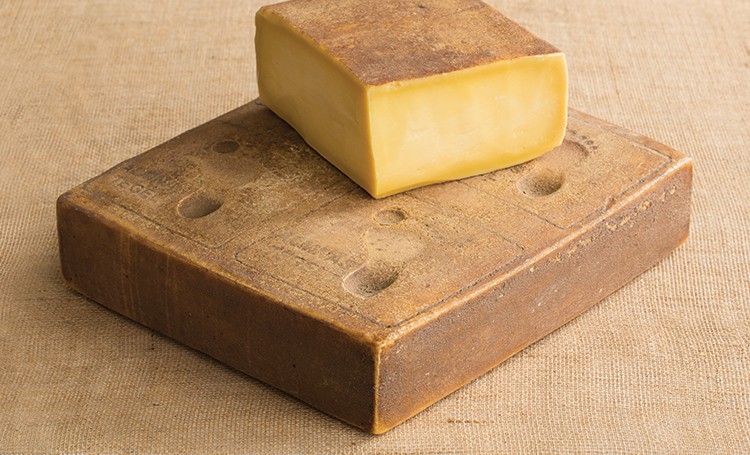
More Than Good Looks
Tegel’s flavor stands up to its impressive appearance. “I like to call it a real grown-up cheese,” says Tommy Larsson, the second Almnäs cheesemaker. “In taste, in size, in shape, and in the surface. It’s not only very beautiful, but full of flavor – you taste flowers, and it’s a little sweet.”
While its recipe is modeled after that of Gruyère, Tegel is the product of its unique location. “Before we started making any cheese, I interviewed quite a few cheesemongers,” Berglund says. “They taught me to be inspired, but [not to] copy.”
Producing Tegel begins with pumping about 1,050 gallons of milk from the farm’s herd of 400 Holstein cows into a gleaming copper vat—the only one of its kind in Sweden, according to Berglund. Two cultures are added to the tank as milk arrives, which is warmed to 32°C. Then, rennet is added.
During the time it takes the milk to coagulate, we go upstairs for fika, the nearly sacred Swedish custom of breaking for coffee, conversation, and a snack. “This is one of the most fantastic moments, these 35 minutes,” says Larsson as he sips coffee. “Four thousand liters of milk becomes like panna cotta, and it goes so fast.”
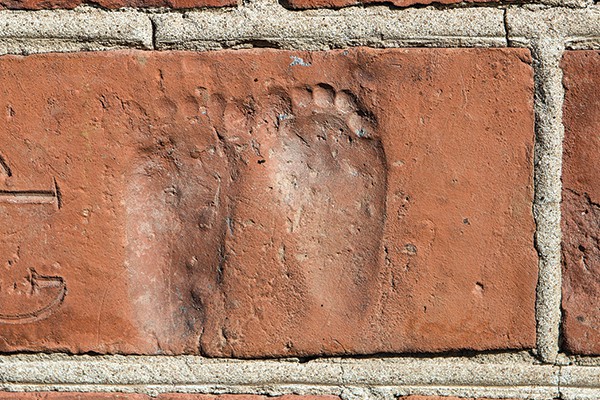
“It’s disco time!” Larsson says with a grin. The curds are cooled just one degree before the contents of the vat are emptied quickly into 14 molds that form each batch of Tegel. It’s quite dramatic: Whey splatters all over the floor as curds pour in, and steam permeates the room, like during a heavy downpour on a hot summer day.
The cheesemakers monitor the molds to ensure that curd distribution is as even as possible. They secure a lid on each mold, and place each under pressure for 19 hours. The cheeses are then unmolded with pressurized air, and the flat bottom panels containing the footprint impressions are lifted off by hand. Any rough edges are trimmed with a razor before the cheeses are submerged in a salt-water bath for 48 hours. Finally, the cheeses are brought to aging rooms and washed with salt water, daily for the first few weeks, then less frequently as time goes on.
Tegel’s appearance changes dramatically as it ages; the freshest batches are a creamy white color, which eventually takes on an orangish hue and ultimately turns deep reddish brown. The youngest cheeses sold are no less than 18 months old.
Its flavor varies with age, too. The 30-month-old version I tasted is wonderfully rich and complex, with a saltiness and prickliness on the tongue balanced by sweetness, caramel, and a hint of grass.
Tegel was named among the top 10 cheeses in Sweden by a panel of 37 chefs in a 2013 issue of the Swedish magazine White Paper, but Berglund isn’t concerned with competition. “We are always trying to improve the cheese we make,” he says. “I’ve met a lot of people who have been very generous [in] sharing knowledge and trying to help us, and we do the same. There’s no hush-hush; everybody lets everybody be inspired by what they do and how they make their cheese.”
Almnäs Bruk currently produces four cheeses, each tied to an aspect of the estate’s history, including original-recipe Wrångebäck cheese. “We try to give people an impression of this place, of our story,” Berglund says. Later he adds, “I’d like to think my father would be very proud if he knew we are making cheese at Almnäs again.”
Want to try Almnäs Tegel for yourself? Purchase our autumn 2014 centerfold cheese through Di Brunos.



